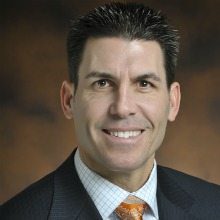WashingtonExec: Could you give us a brief background on yourself and what you are currently working on at DOE?
Peter Tseronis: I work at the Department of Energy as the Chief Technology Officer. I’ve been here a little over four years. My primary mission is to support the entities of our enterprise whether that’s a lab, a program office, a plant, or a power marketing administration through the Office of the Chief Information Officer. One of my roles is to develop an IT policy framework that is both innovative and transformational. It actually has a lot to do with Big Data and how we’re approaching it at the Energy Department.
WashingtonExec: What are you all doing at DOE in terms of Big Data and do you have any particular pilot programs that you want to talk about that you will be rolling out either this year or next year?
Peter Tseronis: I think, as you are well aware, the term Big Data is nebulous. As much as you talk about cloud computing or IPV6 or even just saying ‘what’s the mobile strategy you have’ – there are so many aspects of Big Data. In my book, Big Data has been a part of DOE’s culture for awhile and it’s obviously something I’m taking increasing interest in because of the impact it will have not only on our technical infrastructure but also, for example, on the U.S. electrical grid as well as the scientific research that we are looking into at the Department. The data is there and there are tons of it. Whether it is big or small, the OCIO is ultimately looking at how we use it.
WashingtonExec: Do you see Big Data as the next technology wave?
Peter Tseronis: I think this is an important area for government and is one of the things that I’m excited about with our policy framework which will synthesize different initiatives like mobility, cloud computing, HSPD-12, iCam and Big Data. This is about putting our data together, knowing how to analyze it and extracting the value from it – it’s a challenge for any organization. It’s just yet another thing that could be the glue, the cohesion, to bring together the thinking around how you build a world class infrastructure to take advantage of mobility and at the same time improve how we store data so that it can be analyzed. That’s where you bring the cloud into the picture. This explosion through data stores, social media, other communication networks, the growth of the internet and web 2.0 – this is what has helped create the next thing. I read recently that every day the world creates 2 ½ quintillion bytes of data, so much that 90 percent of the data in the world today has been created in the last two years alone. Where is all of that being stored so that analytics can be done around it? As we open access to the data, the possibilities for innovation and entrepreneurship may expand exponentially.
The Administration’s Green Button Initiative is working to provide millions and millions of households secure access to their energy data with a single click. There are other movements like that that are saying ‘Hey there is, in this case, a lot of electricity data out there that is going to be captured. What can we do with it? How can it benefit certain customers and consumers?’ That’s where you leverage the skills of our entrepreneurial application development community – much like we saw with the Blue Button at the Department of Veterans Affairs. This Green Button Initiative is an exciting thing. Addressing the policies, the privacy and the security concerns is first and foremost. That’s what we need to focus on in government, not just saying ‘yes, we have a strategy for Big Data’, but ultimately how can we utilize our shared services and advance the open government principles of transparency, collaboration, participatory — embracing Steve Van Roekel’s message of being architects of future United States government IT infrastructure and frameworks.
WashingtonExec: Incorporating big data into projects, how is that a part of the overall Administration’s initiative of doing more with less?
Peter Tseronis: It’s doing more with less by thinking differently and creatively. Obviously while we want to reduce IT budgets we also want to increase the value of our services to our citizens. I know that we’re striving for best practices so that each agency can benefit from a process and resources can be shared across government – that’s how, whether in Big Data or another initiative, we begin to do more with less. Cloud and mobility specifically allow us to envision a workforce that can work wherever it needs to and access whatever data and applications it needs to do that work. This transformation is underway. You want to look at how technology is evolving so that we can do our jobs more effectively and with less IT needed to support it. It’s thinking in a different way about doing more with less.
WashingtonExec: Can you give us an update on how the BYOD project is going?
Peter Tseronis: At the Energy Department the goal is to continue to mature our piloting and proof of concepts programs to make sure we establish sustainable, effective BYOD strategies that meet our IT and security requirements and policies. We want to be able to look at the role of the individual and determine the right solution to secure these devices, from smart phones and tablets to laptops, PCs and netbooks. I think role-based user segmentation will drive a lot of our efforts in terms of developing and deploying a BYOD IT policy.
WashingtonExec: DOE is a progressive organization in regards to BYOD policies. What are the biggest challenges you have had in implementing that policy?
Peter Tseronis: To me, BYOD is more or less a sub-policy to our broader mobility strategy. Bring Your Own Device speaks to workforce mobility. I think BYOD is becoming the reality of the situation. We have make sure that whatever policy we establish considers the unique needs of different employees’ jobs. BYOD is also tightly linked with the security. At the Department I’m working closely with our Chief Information Security Officer, Gil Vega, to support a secure IT innovation transformation. That’s making sure that we’re incorporating security needs at every step across policy development and initiative pilots or proof of concept efforts.
WashingtonExec: What do you expect to see in federal IT in the coming months/years?
Peter Tseronis: I expect to see increasing integration and ongoing virtualization of IT. I see today’s cloud “hot trend” as part of the virtualization of IT infrastructure. It’s evolving to include data center network integration for a secure service delivery. When people talk about virtualization and cloud computing, they are discussing changes to our IT infrastructure. I’m pretty passionate about that connection and that’s been one of my messages as of late.
WashingtonExec: What is something most people might not know about you?
Peter Tseronis: I’m a huge Miami Dolphins fan. I went to Villanova University. I’m fired up to get the fourth edition to my family and I’m married to a wonderful woman.
WashingtonExec: Do you have a favorite book?
Peter Tseronis: Believe it or not I’m a late bloomer to the Harry Potter series so I’m working my way through the books. Even though I’ve seen the movies, I’m reading several of those. That’s currently what’s on my bedside as well as my golf magazine. I try to balance that so that I’m not living and breathing IT 24/7.



